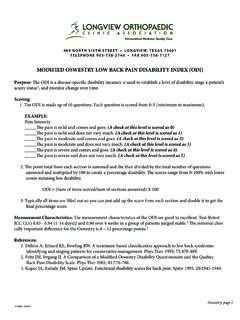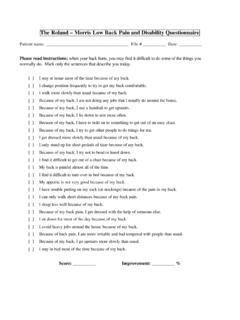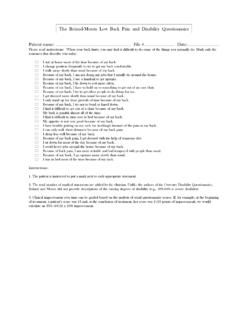Transcription of Efficacy of Neural Mobilization in Treatment of Low Back ...
1 Journal of American Science, 2011;7(4) 566 Efficacy of Neural Mobilization in Treatment of Low back Dysfunctions Sahar M. Adel Department of Basic Science, Faculty of Physical Therapy, Cairo University, Cairo, Egypt. Abstract: The study was conducted to investigate the effect of lumbar Mobilization techniques and Neural Mobilization technique on sciatic pain, functional disabilities, centralization of symptoms in patients, latency of Hoffmann reflex, and of degree of nerve root compromise in chronic low back dysfunction (LBD). Pre-test post-test group design has been used. Sixty patients with chronic (LBD) from both sexes were involved, aged between 30 60 years. They were divided into two equal groups, Group (A) received lumbar spine Mobilization and exercise intervention and Group (B) received Straight leg raising stretching (SLR) in addition to lumbar Mobilization and exercise.
2 Self-report measures included a body diagram to assess the distribution of symptoms, numeric pain rating scale (NPRS), modified Oswestry Disability Index (ODI), Patients recorded the location of their symptoms on the body diagram to determine the extent to which centralization occurred after Treatment , The results of study revealed that: there was a significant difference between both groups on pain (p = ), functional disabilities improvement ( ), location of symptoms (p = ) and sciatic nerve root compression (p = ). However there is no significant Differences in H-reflex latency (p = ) between group A and group B (post test). It is concluded that straight leg raising (SLR) stretching may be beneficial in the management of patients with LBD. SLR stretching in addition to lumbar spine Mobilization and exercise was beneficial in improving pain, reducing short-term disability and promoting centralization of symptoms in this group of patients.
3 [Sahar M. Adel Efficacy of Neural Mobilization in Treatment of Low back Dysfunctions. Journal of American ). -N: 1545]. (ISS573-566 Science 2011;7(4): Key words: Chronic low back dysfunction, Straight leg raising (SLR) stretching, lumbar Mobilization , H-reflex latency. Introduction Lumbar-spine disorders rank fifth among disease categories in the cost of hospital care and account for higher costs resulting in absent from work and disability than any other category (1). Disability associated with low back dysfunction (LBD) continues to rise, contributing to a substantial economic burden that exceeds nearly 50 billion annually in the United States alone. Health care expenditures among individuals with LBD are also 60% greater than those without LBD with 37% of the costs a direct increase of physical therapy services (2). Physical therapists utilize a wide range of interventions in the management of LBD; however, evidence for the effectiveness of these interventions is limited (3).
4 Intervention in patients with a disease requires that the intervention has to be more beneficial, safer, and cost-effective compared with the untreated natural history. Intervention should occur after accurate diagnosis and consideration of prognostic findings. This dilemma is particularly important in patients with low back dysfunction (LBD) with or without radiculopathy (4). The SLR test is frequently used in the assessment of patients presenting with lumbar spine dysfunction and is one of the few indicators that has been shown to identify the degree of impairment from LBD'' Furthermore, it has been suggested that improving the range of SLR has a beneficial effect in restoring normal movement and reducing the degree of impairment due to low back dysfunction (5). Unfortunately, there is no research evidence to support these conjectures.
5 The movement of SLR induces posterior pelvic rotation and thereby flexion of the lumbar spine as well as flexion of the hip. The study was conducted to investigate the effect of lumbar Mobilization techniques and Neural Mobilization technique (SLR stretch) and on sciatic pain, functional disabilities, centralization of symptoms in patients, latency of Hoffmann reflex, and of degree of nerve root compromise in chronic LBP with lumbar radiculopathy (sciatica). Subjects Sixty patients with chronic (LBD) from both sexes were involved, aged between 30 60 years. They were divided into two equal groups, Group (A) received lumbar spine Mobilization and exercise intervention and Group (B) received Straight leg raising stretching (SLR) in addition to lumbar Mobilization and exercise. Patients were required to have symptoms that referred distal to the buttocks, reproduction of the patient s symptoms with straight leg raise testing, no change in symptoms with lumbar flexion or extension, and a baseline Oswestry score greater than 10%.
6 Patients with red flags for a Journal of American Science, 2011;7(4) 567serious spinal condition ( infection, tumors, osteoporosis, spinal fracture, etc.) were excluded. Also patients who were pregnant, has a history of spinal surgery, positive neurologic signs or symptoms suggestive of nerve root involvement (diminished upper or lower extremity reflexes, sensation to sharp and dull, or strength), osteoporosis, or exhibited a straight leg raise (SLR) test of less than 45 were also excluded. Design of the study: The design of study was pre-test post-test group design with dependant variables were pain level, functional disabilities, amplitude of Hoffmann reflex, and degree of nerve root decompression, The independent variables were neurodynamic techniques, and lumbar Mobilization . Instrumentation 1- Magnetic resonance imaging (MRI): Magnetic resonance imaging (MRI) was used to measure degree of nerve root compression by disc herniation using grading system.
7 The system was used in grading compromise of the intraspinal extradural lumbar nerve root consists of four grade categories. Grade 0 (normal): No compromise of the nerve root is seen. There is no evident contact of disk material with the nerve root, and the epidural fat layer between the nerve root and the disk material is preserved. Grade 1 (contact): There is visible contact of disk material with the nerve root, and the normal epidural fat layer between the two is not evident. The nerve root has a normal position, and there is no dorsal deviation. Grade 2(deviation): The nerve root is displaced dorsally by disk material. Grade 3(compression): The nerve root is compressed between disk material and the wall of the spinal canal; it may appear flattened or be indistinguishable from disk material (6). The main reason for MRI referral of patients with chronic radicular pain below the knee without a history of neoplasm, infections, or other rare abnormalities is to distinguish between patients with and without herniated disks.
8 This distinction requires accurate imaging because small herniations can be difficult to detect. The accuracy of MRI for predicting the presence of disk herniations at surgery is relatively high (varying from 76% to 96%), and thus it has become the investigation of choice for patients suspected of lumbar disk herniations (7). 2- NeuroScreen plus Electromyography: NeuroScreen plus Electromyography system was designed to measure electromyography and electroneurography parameters. In this study latency of Hoffmann reflex (H-reflex) was measured. Essentially the Neuroscreen plus system consists of the following components: Computer-incl. A/D converter and control board, 4 channels AC amplifier (floating), Tele panel (control panel), Ink-jet printer. Programmable neuroscreen plus software, and Neuroscreen plus kit: Composed of the following accessories: Cotton, alcohol, scissors, adhesive plaster, and medical gel, Recording, referencing, stimulating, and grounding electrodes with grounding strap.
9 Procedures: A- Evaluative procedure Patients completed a variety of self-report measures, followed by a standardized history and physical examination performed by a physical therapist. Self-report measures included a body diagram to assess the distribution of symptoms, numeric pain rating scale (NPRS), modified Oswestry Disability Index (ODI), Patients recorded the location of their symptoms on the body diagram to determine the extent to which centralization occurred after Treatment , which was determined according to the procedures described by Werneke et al (8) . The standardized history consisted of demographic information including age, gender, past medical history, location and nature of symptoms, relieving/aggravating activities, prior episodes, occupation and leisure activities. The standardized physical examination included measurements of active lumbar range of motion, passive posteroanterior mobility of the lumbar spine (9), myotomal testing, sensory examination to sharp and dull, muscle stretch reflex testing, the SLR test (10).
10 The evaluative instruments included: 1-Health scale device: Health scale device used to measure the weight and the height for each patient 2- Pain assessment The 11-point NPRS ranges from 0 ( no pain ) to 10 ( worst pain imaginable ) and was used to indicate the intensity of current pain and at its best and worst level over the last 24 h (11). These 3 ratings were averaged to arrive at an overall pain score. The scale has been shown to have adequate reliability, validity, and responsiveness in patients with LBP when the 3 scores are averaged (12). 3- Functional disability The functional disability of each patient was assessed by Oswestry disability questionnaire. It consists of 10 multiple-choice questions of LBP included disability in daily function and leisure time Journal of American Science, 2011;7(4) 568activities, for each question the patient select one sentence out of six that best describe his disability.




